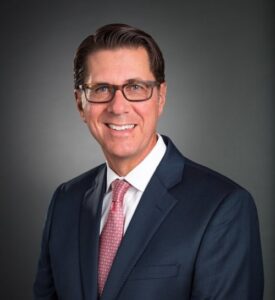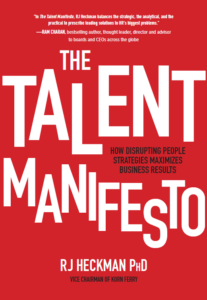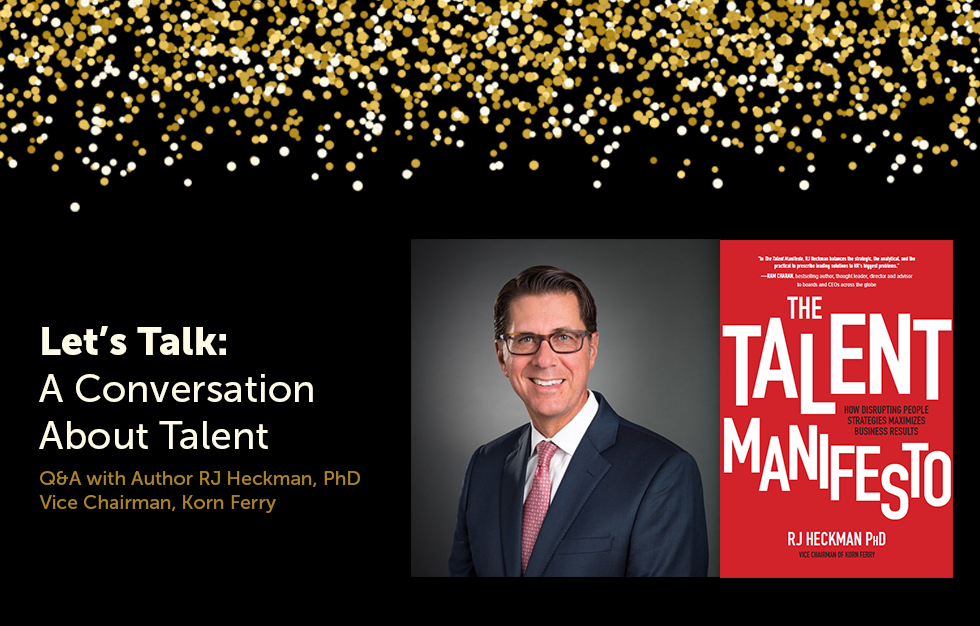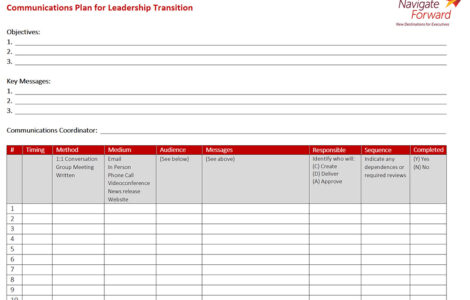In The Talent Manifesto, author and thought leader RJ Heckman incorporates best practices, research and lessons-learned from thousands of global companies to illustrate how companies can achieve optimum performance through talent. Now more than ever, he stresses, businesses need a proactive and strategic approach to their people—one that requires clear differentiation, high-quality data and agility.
We tapped RJ’s knowledge and experience for a Q&A interview.
 Q: What prompted you to write this book?
Q: What prompted you to write this book?
A: I was an HR person for many years, with AT&T, Honeywell and Graco in Minneapolis. Then, I got a Ph.D and was a consultant. I was running businesses, both PDI and Korn Ferry’s advisory business. When I came back to consulting in 2015, I was really interested in what had changed in the field of HR since I was practicing actively.
Q: Was there an “a-ha” moment during your research? An insight that really stood out for you?
A: I have assessed over a hundred CHROs, CEOs, and different people in the C-suite. Many were at the largest organizations in the world.
The bad news was it was very seldom that I was hearing new or different information. In way too many cases, I was hearing the same old stuff I had heard one or even two decades prior. I just had this impression that the HR function had not evolved much at all. The impact that HR leaders and their functions were having was very minimal—and frankly, unimpressive.
Leaders need to be in tune with how every single dollar and hour of HR and talent management is spent, and the extent to which those dollars and hours are directly contributing to the performance of their business.
That prompted me to write the book. In it, I summarize the themes of what great talent strategies look like for higher performing, higher contributing HR functions.
Q: You came up with the concept of the “Talent Waltz.” What does that refer to?
A: Not many of us are ballroom dancers, but the waltz sticks with me because of the rhythm—one, two, three, one, two, three, one, two, three. It’s the steps and the rhythm you need to have, and it corresponds to the three steps you need to drive talent management to higher levels. It has to be in the right order, and at the right tempo.
Q: You call the first of your three Talent Waltz principles the “North Star” for HR and business leaders. Tell me about what that first step of a winning talent strategy is.
A: The first step is aligning business and talent strategy. Being crystal clear on how the business will differentiate and win when competing globally with many other players in its space.
One of the first failure modes for HR leaders, and frankly, leaders overall, is the failure to articulate that very specifically. How will the business differentiate? How will they leverage advantages they may have in their value chain so they beat the competition on price, service, or product?
What I heard most was, “This is our talent strategy because some other company does it.” Microsoft, Google, or Amazon… At which point you’ve got to dig in and say, “Yes, but isn’t your strategy different than theirs?”
What I heard most was, “This is our talent strategy because some other company does it.” Microsoft or Google or Amazon do performance reviews or talent acquisition in this way, so we did it, too. At which point you’ve got to dig in and say, “Yes, but isn’t your strategy different than theirs?”
Q: Let’s talk about the second step. It’s another area where you found sizeable gaps between top performers and less successful organizations, correct?
A: Step two in the waltz is to baseline your current capabilities. Answer the question, do you have the right quantity and the quality of talent that you need—especially in the most critical or pivotal roles—to execute your strategy? It’s really all about data on people.
You’ve got to bring data-based clarity to the question of how capable are your people in delivering on the skillsets needed to execute your strategy.
And here again, in most organizations there’s very poor insight that is quantifiable around capabilities. Very few organizations have data on people that predicts outcomes that drive their business.
You’ve got to bring data-based clarity to the question of how capable are your people in delivering on the skillsets needed to execute your strategy.
It’s usually “Oh, we’re pretty good,” or “Well, we’re having a turnover problem,” or “We think our engineering talent is very, very solid.” You get adjectives that describe in broad brush strokes how strong people are, but it’s really not nearly specific enough to know whether your organization will beat its competition.
Q: You stress that just like in the dance, the steps of the Talent Waltz need to occur in a specific order. You can’t start with action then work your way back to assessment or strategy. Tell me about when and how you execute the third step.
 A: The third step is to move fast in closing the gaps. Put all of those dollars and hours on the shelf, and don’t start using them until you’re very specific about what problem you’re trying to solve.
A: The third step is to move fast in closing the gaps. Put all of those dollars and hours on the shelf, and don’t start using them until you’re very specific about what problem you’re trying to solve.
Too many organizations just do things because they always have. They continue spending tens of millions of dollars on leadership development programs just because people have always enjoyed them.
For example, “We have an incentive program that sends top salespeople to Europe because people like Europe and they enjoy traveling together.” But that’s very different from, “We’re spending this money on this trip because we know that it’s the most effective way to close gaps that we as a business have to close in order to be more effective.”
Q: Data and quantifiable, predictable metrics around human capital seem to be a struggle for many organizations. What’s the biggest obstacle? How can HR leaders really leverage analytics to a competitive advantage?
A: Too often, especially in HR, there’s a fundamental lack of capability and comfort with data. That’s what has thought leaders like Ram Charan saying that HR ought to be bifurcated, where anything quantitative like payroll, workforce planning, compensation, or benefits should shift to finance.
Compared to the evolution of accounting and finance, or sales and marketing, the HR function is far less mature. It lacks the data science, the theoretical principles, that would undergird a robust and more impactful function.
Too often, especially in HR, there’s a fundamental lack of capability and comfort with data. You get adjectives that describe in broad brush strokes how strong people are, but it’s not nearly specific enough to know whether your organization will beat its competition.
In The Talent Manifesto, I’m trying to shine a bright light on those limitations and begin to tee up examples of companies that do these three core principles better than many others before them.
Q: You engage with many C-Suite leaders at companies around the world. What are you seeing in terms of their expectations of HR? How well is the HR function aligned with their senior leadership?
A: There are extraordinary amounts of variability. Sadly, there are still CEOs not in touch with the power that a good talent manager will give them, the power of world class people; they don’t have very specific expectations of how talent is managed in their business.
We call it the “big three” when it’s done well. It’s the CEO, CFO and CHRO talking and acting strategically and in an aligned fashion as they think about the organization’s resources overall—financial and human capital.
But, there are smaller numbers where leadership is more tightly aligned on talent. We call it the “big three” when it’s done well. It’s the CEO, CFO and CHRO forming that triumvirate of a partnership. They’re talking and acting strategically and in an aligned fashion as they think about the organization’s resources overall—financial and human capital.
The opportunity for CHROs is educating their CEOs and the broader executive team so that they are managing talent more strategically, driving the performance of their company. Not just more gold stars for how talent is managed, but truly putting up numbers and financial results because they manage talent more strategically.
Q: The COVID-19 pandemic, a reckoning on race relations, the Great Resignation—obviously, recent events have impacted talent management significantly. How do the three principles in your book help companies better navigate today’s dynamic landscape?
A: The Great Resignation is real, and it can be an expensive problem for some organizations. The pace of change is more rapid now, and the role and expectations of leaders has broadened.
The role and expectation of leaders has broadened. That’s requiring better, stronger leadership and management of talent across the board.
For example, it used to be the case that leaders could avoid tough questions—questions that were outside of the performance of their business itself. Now, they’re expected to get into the mix and have an opinion about what’s going on in their communities or in the world, and even in politics.
So under the microscope, leaders are finding there’s greater urgency to act in a very proactive way. They need to engage the heads, hearts, and guts of their employees. That’s requiring better, stronger leadership and management of talent across the board.
Q: As we sum up, what’s the overall message you’d like HR leaders and readers of The Talent Manifesto to take away?
A: A lot of times, they feel they know this. “Cute ideas, but they don’t apply to me.” That’s just not my view. They’ve got to think more critically about their own business, their own leadership, their own talent practices. They need to be in tune with how every single dollar and hour of HR and talent management is spent, and the extent to which those dollars and hours are directly contributing to the performance of their business.
About RJ Heckman
RJ Heckman, PhD, has worked in talent management and leadership development for 30 years. As Vice Chairman at Korn Ferry, he consults with many of the world’s top organizations. Previously, he worked as an internal HR leader for two Fortune 50 companies and served as CEO of a global leadership advisory firm. As a member of Korn Ferry’s Office of the CEO, he serves as a consultant to boards, CEOs and CHROs of dozens of Global 1000 companies.



